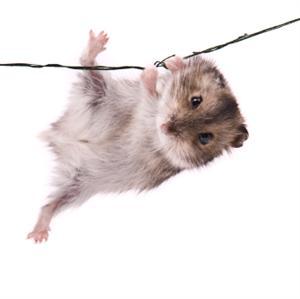| Complexity level: | 6 |
| Project cost ($): | 30 |
| Time required: | 2 day to prepare, 10 hour for observation |
| Material availability: | Easily found |
| Safety concerns: | Wear gloves when handling rodents to prevent getting bitten. |
Hypothesis
Both hamsters and mice are able to learn and remember but mice are able to learn more quickly than hamsters.
Overview
Rodents
Both hamsters and mice belong to the rodent family. They are both mammals. The hamster has thicker fur and a very short tail whereas mice have very thin fur and long tails.
Both the hamster and the rat have very poor eyesight. However they both do have a very keen sense of smell and hearing. They depend on these two senses to evade predators and to scour for food.
Hamsters are well-loved pets. They can be domesticated and kept as pets. They are easy and fairly cheap to maintain. Being lively animals, they love to play in cages and are entertaining to watch. Hamsters are omnivorous, eating small insects and also fruits or nuts.
Mice are also kept as pets at home but more often than not, they are known as pests, entering our homes and scavenging for food. Mice are also known to spread certain forms of dangerous diseases. Initially mice were found in farms and were a problem because they ate and damaged crops. From the onset of urbanization, they have adapted to living in sewage and draining systems across cities.
Their high rate of reproduction has made mice and hamsters suitable laboratory subjects.
Scientific Terms
Materials
The materials required for this experiment:
- 3 hamsters
- 3 white mice
- 1 packet of sunflower seeds
- A variety of cardboard boxes (as many as may be required to make the maze)
- 1 pair of scissors
- 1 roll of masking tape
- 1 bottle of glue
- 1 stopwatch
- 1 meter-long ruler
Procedure
- For this experiment, the independent variable is the learning ability of the hamsters and the mice. The dependent variable is the time taken for the hamsters and mice to complete the maze. This is determined by measuring the time using a stopwatch. The constants (control variables) are the size and type of the maze, the hunger levels of the rodents and the type of food used to lure them through the maze.
- Construct a maze approximately 100 cm x 200 cm in size using cardboard boxes, glue and masking tape. The height of the maze must be at least 15 cm so that the rodents do not jump out of the maze. See figure 1 for an example of the maze.
- Once the maze is completed, it is left outside for 2 days for the smell of the glue to diminish. This is because the hamster and mice depend on smell to locate their food and the smell of the glue can be a distraction.
- A few sunflower seeds are placed in the finish zone of the maze. The hamster and the mice are dropped in the start zone of the maze one at a time. The time taken for each of the hamsters and mice to find the food is timed and recorded in the table given below.
- The procedure 4 is repeated a total of 10 times, once every hour and all the timings are recorded in the table.


Results
The mice and the hamsters were able to improve their timings after every attempt showing that they were learning and remembering the paths inside the maze. The mice were also able to complete the maze faster than the hamsters.

Use graph below to plot the results of table above. 
Conclusion
The hypothesis that both hamsters and mice are able to learn and remember, but that mice are able to learn faster than hamsters, is proven to be true.
Mice and hamsters are mammals, just like us human beings. Therefore humans and rodents share some similar characteristics and even genetic similarities. This makes rodents, especially mice, very suitable lab animals to conduct experiments that cannot be done on human beings.
Also consider
The experiment can also be done using a different kind of feed like dried shrimp.
How different will your results be, if the length of time between the attempts in increased, like once a day?
Would there be a difference if you were to use young mice/hamsters instead of fully grown creatures?
References
Hamster - http://en.wikipedia.org/wiki/Hamster
Mouse - http://en.wikipedia.org/wiki/Mouse

